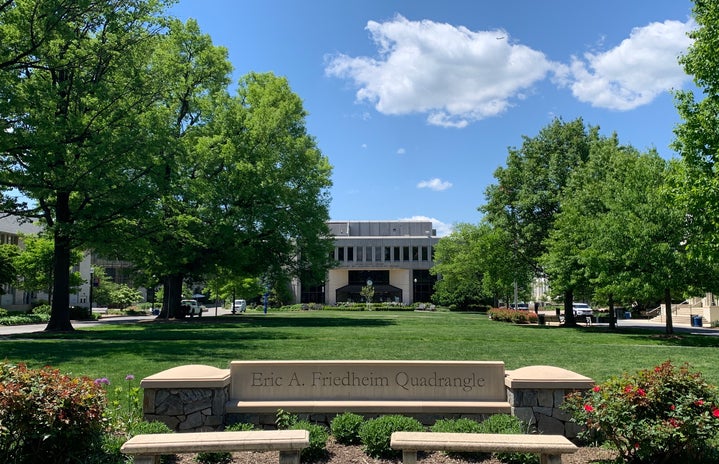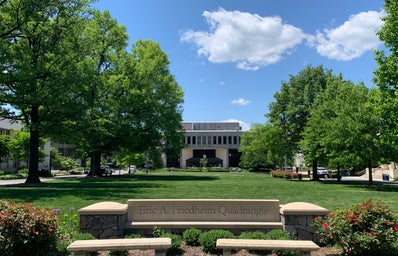When you think of American University, what comes to mind? Being located in Washington, D.C., Capitol Hill ‘hillternships’ may be the first thing you think of. Or maybe you think of students dedicated to political engagement and activism. Science, technology, engineering and math, otherwise known as STEM, might not be one of the first things that comes to mind—but it should be.
Whether it be the associations with being in the political capital or how the university brands itself, STEM tends to fall by the wayside in terms of visibility. Dr. Anthony Riley, who has been at the university for an impressive 47 years and serves as Neuroscience Department Chair, explains that “students don’t really know that we do science here.”
Part of this might be because American University follows the traditional liberal arts model of having arts, pure sciences, humanities and social sciences in one umbrella school—the College of Arts and Sciences (CAS). In this way, STEM departments are placed in the same administrative unit as other departments with vastly different goals and functions. This made it difficult for there to be any semblance of a STEM identity at AU, especially because, as Dr. David Kearns, Department of Psychology Chair, highlights, “historically, AU hasn’t been thought of as a science school.”
Things are changing, however, especially with the development of the Don Meyers Technology and Innovation Building (DMTI) and the Hall of Science. Just five years ago, the sciences were separated with the biology department in Hurst, chemistry in Beeghly and psychology in Asbury. With the physical landscape of AU changing, so has the STEM morale. According to Riley, having buildings dedicated to STEM has been a great way to unite staff and students. Another neuroscience professor, Dr. Mark Laubach, says that the buildings have “changed the spirit” of the departments and created “a better home for science.”
Despite having their own buildings, STEM departments being within the College of Arts and Sciences still poses challenges. According to Kearns, the STEM departments heavily lean on external funding—money from outside the school—to run their research programs. As such, it is important to attract investors to the university and convince them to spend their dollars here as opposed to other institutions. But, as Laubach and Riley both highlight, because of the size of CAS and the constant flow of news coming from 19 different departments, it can be hard to advertise the STEM work going on at AU to get attention from funders. This exemplifies the importance of promoting what the STEM programs are doing at American University.
What, then, are STEM programs doing that are unique to the university? Dr. Karen Knee, Department Chair of Environmental Science, points to the ability of undergraduates to get involved at a higher level in research opportunities because of small program sizes. She spotlights the fact that undergraduates have more personal interactions with faculty—a relationship that Laubach believes is incredibly important, as faculty are not just educators, but active researchers and participants in their fields.
American University is also home to many labs. Opportunities to get hands-on experiential learning in a lab might be limited to post-graduate students at other institutions, but that is not the case here. The Hall of Science has 12 state-of-the-art laboratories that have student workers participating in ongoing research.
Another selling point is that being in Washington, D.C. is not only a value to those going into politics. Laubach and Kearns both emphasize the benefit of being the closest university to the National Institute of Health (NIH). There are significant post-graduate opportunities at the NIH that American University students routinely fill thanks to the aforementioned opportunities at the university.
This is information that professors wish students knew. Professor Jaime Miller, Senior Lecturer in mathematics and statistics, says that she wants the department to move past the image of “where you take your one math class”—something Miller has heard AU ambassadors say when giving tours. Laubach recalls hearing tour leaders standing outside of the Hall of Science saying that they “don’t know what goes on in there.”
It is clear that the reputation of STEM at American University starts, in part, with the way we brand our school, down to the tours we give to prospective students. A potential way to address this issue is having presentations and tours that bring people into the buildings to tangibly grasp what is happening.
Miller explains that it is also up to first-year advisors. She hopes to better educate advisors on what the STEM programs have to offer so that students who are interested in STEM aren’t turned away or discouraged by advisors who sway them away from courses that have the misrepresentation of being “too complicated.”
Aside from more effective promotion, there are other ways STEM is struggling to expand. Requiring a quantitative literacy and natural-scientific inquiry course in the list of classes needed to graduate added a significant responsibility to STEM departments—where these classes are usually taken—that the professional schools like the School of International Studies, Kogod School of Business and the School of Public Affairs did not have to undertake.
Knee explains, “AU Core created a whole new set of classes that need to be taught by someone, but there is no mechanism of allocating those classes fairly or efficiently.”
Additionally, though the STEM departments are growing, professors report that the internal funding from the school is not. This makes it difficult for the departments to hire the faculty necessary to fully serve students interested in the classes they offer.
Knee points out that if the departments have trouble accommodating current students, they cannot start to market the majors to new people. Professors reveal that budgets are tight across the university and that it can be hard to find new ways to expand funding, but faculty is the top priority in terms of developing the STEM majors to reach their full potential.
Despite challenges that are inevitable at any university, it is clear that American is home to a thriving and dynamic STEM community, where faculty members and students are engaged in cutting-edge research and innovation. American University is witnessing a transformation in the perception and vitality of its STEM programs, and that starts with the students. To find out more about what is going on in STEM here at the university, visit the department pages on the CAS website and look out for flyers, posts and other ways to engage with the very active STEM extracurriculars.


